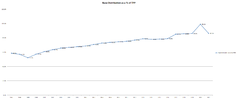- Moderator
- #1
Its coming up soon, so time for a new thread.
Most clubs will report between mid november and the end of the year. AFL reports will come out some time in March.
As always Im grateful to everyone here on Bigfooty and on my twitter feed who has had meaningful contributions in these threads over the last few years. Folks like RussellEbertHandball, Prince Imperial, dave10, Rob have been invaluable with their input over the years, others have assisted with obtaining annual reports in the early years, and still others have assisted with constructive criticism and great questions, particularly Kwality lol
This has always been a colloborative effort. If you see something that is incorrect, please let me know so I can fix it.
Previous Years threads:
Trackers
2021 Reports Table
2020 Reports Table
2019 Reports Table
Most clubs will report between mid november and the end of the year. AFL reports will come out some time in March.
As always Im grateful to everyone here on Bigfooty and on my twitter feed who has had meaningful contributions in these threads over the last few years. Folks like RussellEbertHandball, Prince Imperial, dave10, Rob have been invaluable with their input over the years, others have assisted with obtaining annual reports in the early years, and still others have assisted with constructive criticism and great questions, particularly Kwality lol
This has always been a colloborative effort. If you see something that is incorrect, please let me know so I can fix it.
Previous Years threads:
- 2020 Annual Report Thread
- 2019 Annual Report Thread
- 2018 Annual Report Thread
- 2017 Annual Report thread
- 2016 Annual Report thread
- 2015 Annual Report thread
- 2014 Annual Report thread
- 2013 Annual Report thread
- 2012 Annual Report thread
- 2011 Annual Report thread
- 2020 AFL Annual Report
- 2020 AFL Concise Annual Report
- AFL Stadia 2020 Annual Report
- 2020 Adelaide Annual Report
- 2020 Brisbane Annual Report
- 2020 Carlton Annual Report
- 2020 Collingwood Annual Report
- 2020 Essendon Annual Report
- 2020 Fremantle Annual Report
- 2020 Geelong Annual Report
- 2020 Gold Coast Annual Report
- 2020 Greater Western Sydney Annual Report
- 2020 Hawthorn Annual Report
- 2020 Melbourne Annual Report
- 2020 North Melbourne Annual Report
- 2020 Port Adelaide Annual Report
- 2020 Richmond Annual Report
- 2020 St Kilda Annual Report
- 2020 Sydney Annual Report
- 2020 West Coast Annual Report
- 2020 Footscray Annual Report
Trackers
2021 Reports Table
2020 Reports Table
2019 Reports Table
Last edited:





